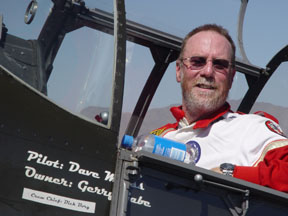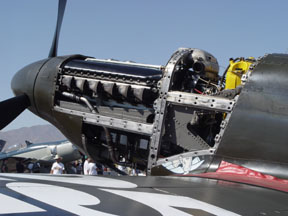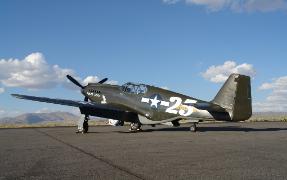By Karen Morss
Mustang, last year that he decided to do it again. But like most air racing efforts, nothing comes easy. The last week in June, my husband and race pilot, Dave Morss, flew down to Hollister, CA, to do a test flight with a new alternator. Everything seemed A-ok when he taxied back to the hangar after delighting the locals with a few low passes.
obvious problem. The new Allison engine installed for last year’s race, was making metal. The engine had twelve hours total time so we were stumped. To make matters worse, the local shop that did the engine overhaul was overflowing with Reno projects so no help to be had there. An engine shop in Washington agreed to take the project so Dick and Jerry pulled the engine, put it on the back of a borrowed pick up truck and off Jerry drove to Arlington, Washington. The disassembled engine revealed a failure of one main crankshaft bearing which also severely gouged the crankshaft journal. It became apparent that the crankshaft also needed to be replaced. No easy task on these Allison engines. The engine shop located a new crankshaft and soon it was on its way to Seattle. Somewhere along the way, its shipping crate was pierced by a fork lift. This caused a delay of several weeks, as it had to be X-rayed for possible damage, insurance claims dealt with, and finally re-crating and shipping back to Washington. It got “lost” for a few days along the way. In late August, Jerry drove back to Washington and picked up the engine. New rings, NOS main thrust nose bearing, all main crank bearings and another crankshaft were installed along with all new seals and gaskets. They ran the engine for four hours. With just two weeks to spare, the engine was on its way, back to Hollister. Many, many late nights later with the entire oil cooling system removed for cleaning and the engine re-installed, Polar Bear was ready for flight test by Dave. The power wouldn’t come up smoothly through the mid-range rpm. The carburetor was removed and Dave flew it to Tehachapi for flow testing and tweaking, and picked it up the next day. Re-installed, everything checked out and it was time to go racing. Dave qualified Polar Bear at 334.995 mph, 23rd in a field of 27. The good news was that the new oil cooler worked but the engine wasn’t making as much power as last year. Dave went to our trusty engine theorist, Dan Whitney, and discussed the problem. Dan thought and was correct that the intake air to the carburetor was not sealed sufficiently. Our McGyver-like crew chief fabricated a fix using a Folgers coffee can, some clamps, safety wire and aluminum tape. It worked. Dave finished 3rd in the Medallion race on Thursday with a speed of 341.995 and 4th in Saturday’s race at 345.424. Lo and behold when we got the pairings for Sunday’s finale, the Bronze race, Polar Bear had the pole. The planes ahead of us moved up to Silver because other planes broke or their speeds were faster. But that meant we would go head to head with the fabulous Race 57, Super Corsair, a veteran of the Cleveland Air races. Bob Odegaard flew the F2G Corsair starting from the last position. Dave had the lead but each lap Bob moved up a spot until he finally caught Dave right in front of the grandstands on lap 5. Then just moments later on the backcourse, he pulled off and called a mayday. You hate to win because somebody else breaks but that is part of air racing. Everyone breathed a sigh of relief as Bob touched down and made a beautiful landing. But no one cheered more than the crew of Race 25, as Dave flew Polar Bear on that final lap to take the checkered flag for our first Unlimited win at Reno. Can’t wait till next year. Karen Morss History of P51-A N51Z Polar Bear, #43-6006, was built by North American at Inglewood, CA for the United States Army Air Corps. The aircraft was accepted by the AAC at Mines Field (now LAX) on April 3rd, 1943. On that same day, the aircraft left Los Angeles for Ladd Army Airfield in Alaska with stops at Long Beach, Hill Field, Gore Field and Edmonton, Canada, arriving at Ladd on May 1, 1943. February 18, 1944 with only 43 hours total time, the aircraft crashed near Summit, Alaska in heavy snow on a VFR flight plan. The pilot, Second Lt. Edward W. Getter was killed. The aircraft remained on that mountain, exposed to the weather and occasional visits by local hunters, who scribed their names on the engine valve covers. In the fall of 1977, more than thirty years after the crash, a very determined Waldon “Moon” Spillers, with the help of two friends, removed the wreckage from the side of the mountain, too steep for helicopters. The aircraft remains were shipped to Ohio, where Waldon rebuilt the aircraft. Working on it almost everyday, Polar Bear flew again on July 3, 1985. In the spring of 1995, with just over 100 hours flying time since rebuild, the aircraft was sold to its current owner, Jerry Gabe, who lives in Hollister, CA. A twelve-cylinder Allison V1710 engine and Curtis Electric three-blade propeller power the aircraft. |

| Polar Bear Pilot - Dave Morss |

| Polar Bear's Allison engine |
| Special Thanks to Naomi West and Dan Whitney for their spectacular photos. |



| Racing |
